A) becomes steeper.
B) becomes flatter.
C) stays constant.
D) becomes steeper and then becomes horizontal.
Correct Answer

verified
Correct Answer
verified
Multiple Choice
Use the following to answer questions: 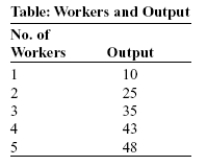 -(Table: Workers and Output) Look at the table Workers and Output. After graduation you achieve your dream of opening an art shop that specializes in selling mud statues. You pay $10 per day on a loan from your uncle, and regardless of how much you produce, you pay $10 per day to each of the workers who make the mud statues. The fixed cost of producing 25 statues is:
-(Table: Workers and Output) Look at the table Workers and Output. After graduation you achieve your dream of opening an art shop that specializes in selling mud statues. You pay $10 per day on a loan from your uncle, and regardless of how much you produce, you pay $10 per day to each of the workers who make the mud statues. The fixed cost of producing 25 statues is:
A) $10.
B) $20.
C) $25.
D) $35.
Correct Answer

verified
Correct Answer
verified
Multiple Choice
The U shape of the long-run average total cost curve is primarily due to:
A) technological change.
B) economies and diseconomies of scale.
C) increasing and then diminishing returns.
D) diminishing returns.
Correct Answer

verified
Correct Answer
verified
Multiple Choice
At quantities less than the long-run minimum cost per unit of output, the long-run average total cost curve is _____ of the corresponding short-run average total cost curve.
A) tangent to the minimum
B) tangent to the maximum
C) to the right of the minimum
D) to the left of the minimum
Correct Answer

verified
Correct Answer
verified
Multiple Choice
Use the following to answer questions: 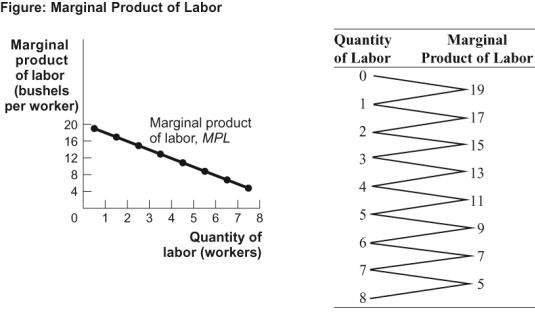 -(Figure: Marginal Product of Labor) Look at the figure The Marginal Product of Labor. The total product for three workers is _____ bushels.
-(Figure: Marginal Product of Labor) Look at the figure The Marginal Product of Labor. The total product for three workers is _____ bushels.
A) 51
B) 45
C) 39
D) 15
Correct Answer

verified
Correct Answer
verified
Multiple Choice
If the marginal cost of the first sports jersey is $21, the marginal cost of the second sports jersey is $40, and the marginal cost of the third jersey is $17, what is the total variable cost of producing three jerseys?
A) $26
B) $78
C) $17
D) $61
Correct Answer

verified
Correct Answer
verified
Multiple Choice
Which of the following statements is FALSE?
A) When the marginal product of labor is upward-sloping, the marginal cost curve is upward-sloping.
B) The average fixed cost curve is downward-sloping and approaches the horizontal axis.
C) The marginal cost curve intersects the average variable cost curve at the minimum of average variable cost.
D) When the marginal cost curve is above the average cost curve, the average cost curve is upward-sloping.
Correct Answer

verified
Correct Answer
verified
Multiple Choice
Use the following to answer questions:
Figure: The Average Total Cost Curve 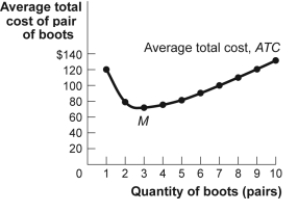 -(Figure: The Average Total Cost Curve) Look at the figure The Average Total Cost Curve. The total cost of producing three pairs of boots is approximately:
-(Figure: The Average Total Cost Curve) Look at the figure The Average Total Cost Curve. The total cost of producing three pairs of boots is approximately:
A) $24.
B) $72.
C) $75.
D) $216.
Correct Answer

verified
Correct Answer
verified
Multiple Choice
When a firm adds capital, in the short run variable costs for any level of output will:
A) increase.
B) decrease.
C) remain the same.
D) increase at first and then decrease.
Correct Answer

verified
Correct Answer
verified
Multiple Choice
When Caroline's dress factory hires two workers, the total product is 50 dresses. When she hires three workers, total product is 48, and when she hires four workers, total product is 45. The marginal product of the third and fourth workers is:
A) increasing and positive.
B) increasing and negative.
C) decreasing and positive.
D) decreasing and negative.
Correct Answer

verified
Correct Answer
verified
Multiple Choice
A factor of production whose quantity CANNOT be changed during the short run is a(n) _____ factor of production.
A) marginal
B) fixed
C) incremental
D) variable
Correct Answer

verified
Correct Answer
verified
True/False
If average total cost is declining, marginal cost cannot be increasing.
Correct Answer

verified
Correct Answer
verified
Multiple Choice
Use the following to answer questions: 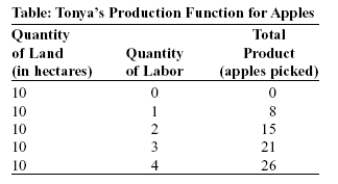 -(Table: Tonya's Production Function for Apples) Look at the table Tonya's Production Function for Apples. Tonya's fixed:
-(Table: Tonya's Production Function for Apples) Look at the table Tonya's Production Function for Apples. Tonya's fixed:
A) input is land.
B) input is labor.
C) inputs are land and labor.
D) inputs are neither land nor labor.
Correct Answer

verified
Correct Answer
verified
Multiple Choice
The long run is a planning period:
A) over which a firm can consider all inputs as variable.
B) of at least five years.
C) of more than six months.
D) of 6 months to 5 years.
Correct Answer

verified
Correct Answer
verified
Multiple Choice
A factor of production whose quantity can be changed during the SHORT run is a(n) _____ factor of production.
A) marginal
B) fixed
C) incremental
D) variable
Correct Answer

verified
Correct Answer
verified
Multiple Choice
Use the following to answer questions:
Figure: Short-Run Costs II 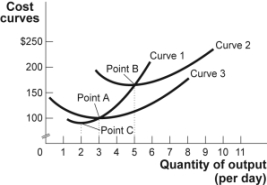 -(Figure: Short-Run Costs II) Look at the figure Short-Run Costs II. At 6 units of output, average total cost is approximately:
-(Figure: Short-Run Costs II) Look at the figure Short-Run Costs II. At 6 units of output, average total cost is approximately:
A) $100.
B) $120.
C) $170.
D) $250.
Correct Answer

verified
Correct Answer
verified
Multiple Choice
Use the following to answer questions: 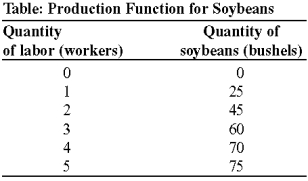 -(Table: Production Function for Soybeans) Look at the table Production Function for Soybeans. Assume that the fixed input, capital, is 10 acres of land and a tractor, which have a combined cost of $150 per day. The cost of labor is $100 per worker per day. The variable cost of producing 25 bushels of soybeans is:
-(Table: Production Function for Soybeans) Look at the table Production Function for Soybeans. Assume that the fixed input, capital, is 10 acres of land and a tractor, which have a combined cost of $150 per day. The cost of labor is $100 per worker per day. The variable cost of producing 25 bushels of soybeans is:
A) $50.
B) $100.
C) $150.
D) $250.
Correct Answer

verified
Correct Answer
verified
Multiple Choice
Economies and diseconomies of scale are associated with the:
A) long-run average total cost curve and the long run.
B) short-run average total cost curve and the short run.
C) marginal cost curve and both the long and short run.
D) average fixed cost curve and the short run.
Correct Answer

verified
Correct Answer
verified
Multiple Choice
In economics, the short run is:
A) less than 1 week.
B) less than 1 month.
C) enough time to vary output but not plant capacity.
D) enough time to change all inputs to production.
Correct Answer

verified
Correct Answer
verified
Multiple Choice
The larger the output, the more output over which fixed cost is distributed. Called the _____ effect, this leads to a ______ average _____ cost.
A) spreading; lower; fixed
B) spreading; higher; fixed
C) diminishing returns; lower; variable
D) diminishing returns; higher; variable
Correct Answer

verified
Correct Answer
verified
Showing 261 - 280 of 362
Related Exams